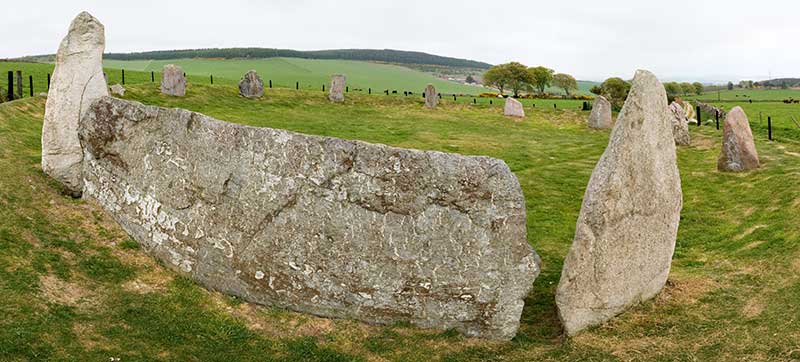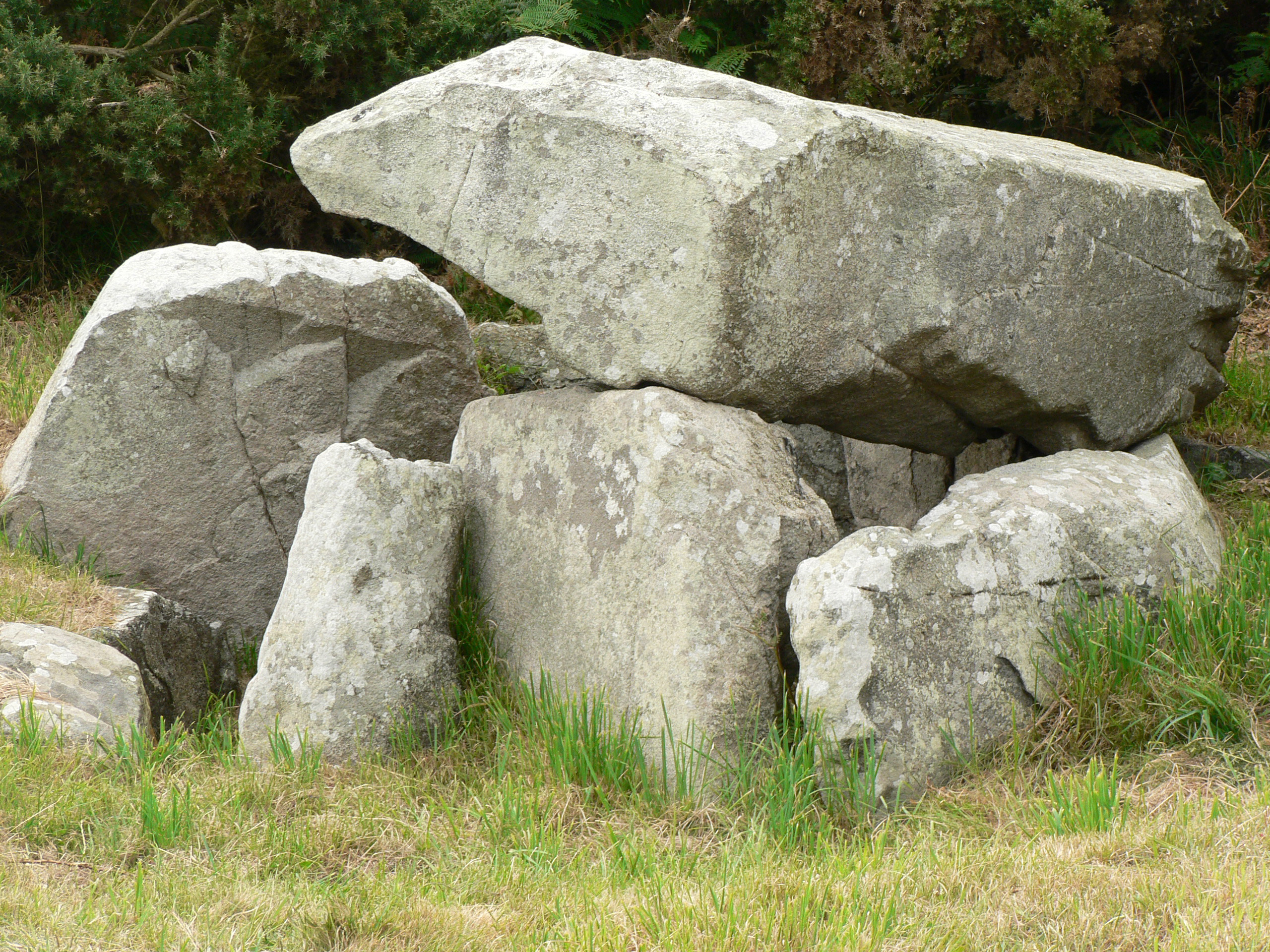|
Duddo Five Stones
Duddo Five Stones () is a stone circle north of Duddo in North Northumberland, approximately 4 miles (6 km) South of the Scottish Border. The stones were known as the Four Stones until 1903, when the fifth stone was re-erected to improve the skyline. There were originally seven stones, the empty sockets of two stones being found on the western side during excavation in the 1890s. The stones are formed of a soft sandstone. They have become deeply fissured by natural weathering since erection in the Early Bronze Age, approximately 4000 years ago. The site of the Duddo Stones offers panoramic views of the Cheviot Hills to the South and the Lammermuir Hills to the north. The circle is accessible via the B6354 road, through a gate and up a path. The stones are on private land with no formal right of way, but the landowner has cleared a permissive path across the field to the stones. The location was the subject of an archeological investigation in 2008. See also *The Goatston ... [...More Info...] [...Related Items...] OR: [Wikipedia] [Google] [Baidu] |
Northumberland
Northumberland ( ) is a ceremonial counties of England, ceremonial county in North East England, on the Anglo-Scottish border, border with Scotland. It is bordered by the North Sea to the east, Tyne and Wear and County Durham to the south, Cumbria to the west, and the Scottish Borders council area to the north. The town of Blyth, Northumberland, Blyth is the largest settlement. Northumberland is the northernmost county in England. The county has an area of and a population of 320,274, making it the least-densely populated county in England. The south-east contains the largest towns: Blyth, Northumberland, Blyth, Cramlington, Ashington, Bedlington, and Morpeth, Northumberland, Morpeth, the last of which is the administrative centre. The remainder of the county is rural, the largest towns being Berwick-upon-Tweed in the far north and Hexham in the south-west. For local government purposes Northumberland is a Unitary authorities of England, unitary authority area. The county Histo ... [...More Info...] [...Related Items...] OR: [Wikipedia] [Google] [Baidu] |
Architecture Of England
The architecture of England is the architecture of the historic Kingdom of England up to 1707, and of England since then, but is deemed to include buildings created under English influence or by English architects in other parts of the world, particularly in the English overseas possessions and the later British Empire, which developed into the present-day Commonwealth of Nations. Apart from Anglo-Saxon architecture, the major non-vernacular forms employed in England before 1900 originated elsewhere in western Europe, chiefly in France and Italy, while 20th-century Modernist architecture derived from both European and American influences. Each of these foreign modes became assimilated within English architectural culture and gave rise to local variation and innovation, producing distinctive national forms. Among the most characteristic styles originating in England are the Perpendicular Gothic of the late Middle Ages, High Victorian Gothic and the Queen Anne style. Prehisto ... [...More Info...] [...Related Items...] OR: [Wikipedia] [Google] [Baidu] |
Stone Circle
A stone circle is a ring of megalithic standing stones. Most are found in Northwestern Europe – especially Stone circles in the British Isles and Brittany – and typically date from the Late Neolithic and Early Bronze Age, with most being built between 3300 and 2500 BC. The best known examples include those at the henge monument at Avebury, the Rollright Stones, Castlerigg, and elements within the ring of standing stones at Stonehenge. Scattered examples exist from other parts of Europe. Later, during the Iron Age, stone circles were built in southern Scandinavia. The archetypical stone circle is an uncluttered enclosure, large enough to congregate inside, and composed of megalithic stones. Often similar structures are named 'stone circle', but these names are either historic, or incorrect. Examples of commonly misinterpreted stone circles are ring cairns, burial mounds, and kerb cairns. Although it is often assumed there are thousands of stone circles across the Br ... [...More Info...] [...Related Items...] OR: [Wikipedia] [Google] [Baidu] |
Duddo
Duddo is a village and Civil parishes in England, civil parish in Northumberland, about southwest of Berwick-upon-Tweed. History Duddo Five Stones is a stone circle to the north of the village. It is a Scheduled Monument. Duddo Tower, south of the village, was built late in the 16th century. It is now a ruin and a Scheduled Monument. It replaced an earlier tower built in 1496. Churches and school The Church of England parish church of All Saints' Day, All Saints is a Gothic Revival architecture, Gothic Revival building. It is in a English Gothic architecture#Decorated Gothic, Decorated Gothic style and was completed in 1879. All Saints' church replaced the earlier parish church of James, son of Zebedee, St James the Great, which was designed by Ignatius Bonomi in a neo-Norman architecture, Norman style and built in 1832. It was later converted into part of the parish school, presumably when All Saints' church was built. The school has since closed and the building is ... [...More Info...] [...Related Items...] OR: [Wikipedia] [Google] [Baidu] |
Bronze Age
The Bronze Age () was a historical period characterised principally by the use of bronze tools and the development of complex urban societies, as well as the adoption of writing in some areas. The Bronze Age is the middle principal period of the three-age system, following the Stone Age and preceding the Iron Age. Conceived as a global era, the Bronze Age follows the Neolithic, with a transition period between the two known as the Chalcolithic. The final decades of the Bronze Age in the Mediterranean basin are often characterised as a period of widespread societal collapse known as the Late Bronze Age collapse (), although its severity and scope are debated among scholars. An ancient civilisation is deemed to be part of the Bronze Age if it either produced bronze by smelting its own copper and alloying it with tin, arsenic, or other metals, or traded other items for bronze from producing areas elsewhere. Bronze Age cultures were the first to History of writing, develop writin ... [...More Info...] [...Related Items...] OR: [Wikipedia] [Google] [Baidu] |
Cheviot Hills
The Cheviot Hills (), or sometimes The Cheviots, are a range of uplands straddling the Anglo-Scottish border between Northumberland and the Scottish Borders. The English section is within the Northumberland National Park. The range includes The Cheviot (the highest hill), plus Hedgehope Hill to the east, Windy Gyle to the west, and Cushat Law and Bloodybush Edge to the south. The hills are sometimes considered a part of the Southern Uplands of Scotland as they adjoin the uplands to the north. Since the Pennine Way runs through the region, the hills are also considered a part of the northern Pennines although they are separated from the Cheviot Hills by the Tyne Gap, part of which lies within the southern extent of the Northumberland National Park. The Cheviot Hills are primarily associated with geological activity from approximately 480 to 360 million years ago, when the continents of Avalonia and Laurentia collided, resulting in extensive volcanic activity (the Caledonia ... [...More Info...] [...Related Items...] OR: [Wikipedia] [Google] [Baidu] |
Lammermuir Hills
The Lammermuirs are a range of hills in southern Scotland, forming a natural boundary between East Lothian and the Borders. The name ''Lammermuir'' comes from the Old English , meaning "moorland of the lambs". Geology The Lammermuir Hills are formed from a succession of Silurian and Ordovician age marine sediments known as greywackes together with siltstones, shales and mudstones. They are assigned to the Gala Group. Unconformably overlying these highly faulted and folded strata are outcrops of the early Devonian age Great Conglomerate Formation which forms a part of the Reston Group of Old Red Sandstone rocks. These coarse red-purple conglomerates underlie a band of country in the east between Longformacus and Oldhamstocks and also occur in an isolated outcrop east of Soutra Hill and beneath the Dun Law Wind Farm on the western margin of the hills. The same strata extend down Lauderdale on the western margin of the hills. Numerous dykes of different lithologies ... [...More Info...] [...Related Items...] OR: [Wikipedia] [Google] [Baidu] |
Permissive Path
In England and Wales, excluding the 12 Inner London boroughs and the City of London, the right of way is a legally protected right of the public to pass and re-pass on specific paths. Private rights of way or easements also exist. The law in England and Wales differs from Scots law in that rights of way exist only where they are so designated (or are able to be designated if not already), whereas in Scotland any route that meets certain conditions is defined as a right of way, and in addition, there is a general presumption of access to the countryside (the "right to roam"). Definitive maps Definitive maps of public rights of way have been compiled for all of England and Wales, as a result of the National Parks and Access to the Countryside Act 1949, except the 12 Inner London boroughs, which, along with the City of London, were not covered by the Act. Definitive maps exist for the Outer London boroughs. Local highways authorities (usually county councils or unitary ... [...More Info...] [...Related Items...] OR: [Wikipedia] [Google] [Baidu] |
The Goatstones
The Goatstones is a Bronze-Age four-poster stone circle located near Ravensheugh Crags in Northumberland, England. It is 2.5 miles (4.0 km) to the north of Hadrian's Wall in the parish of Wark-on-Tyne. The name is thought to be derived from the Saxon "gyet stanes" meaning "wayside stones". The monument probably had some kind of religious purpose. The stones are no higher than , and are separated by a distance of approximately . The smallest stone is decorated with 13 cup marks, or small depressions in the rock, a well known form of prehistoric rock art in Northumberland. The Goatstones is the only recorded example of a four-poster stone circle bearing cup marks. Grooves can be seen on some of the other stones. Within the circle there are traces of a low mound. This is thought to be the remains of a stone cairn which predates the construction of the stone circle and may have been the site of Bronze-Age burials. Four-poster stone circles are found mainly in Scotland, particu ... [...More Info...] [...Related Items...] OR: [Wikipedia] [Google] [Baidu] |
Stone Circles In The British Isles And Brittany
The stone circles in the British Isles and Brittany are a megalithic tradition of monuments consisting of standing stones arranged in rings. These were constructed from 3200 to 2000 BCE in Great Britain, Ireland and Brittany. It has been estimated that around 4,000 of these monuments were originally constructed in this part of north-western Europe during this period. Around 1,300 of them are recorded, the others having been destroyed. Although stone circles have been erected throughout history by a variety of societies and for a variety of reasons, in the Late Neolithic and Early Bronze Ages, this particular tradition was limited to Great Britain, Ireland and the neighbouring area of continental Europe now known as Brittany. The rings were not distributed equally across this area, but were concentrated in several highland regions: north-eastern and central Scotland, the Lake District, the south-west peninsula of England, and the north and south-west of Ireland. Sparser groupings ... [...More Info...] [...Related Items...] OR: [Wikipedia] [Google] [Baidu] |
List Of Stone Circles
This is an incomplete photographic list of stone circles. Australia See also Aboriginal stone arrangement Stone circles in Australia are sometimes revered as sacred sites by Australian Aboriginal people's. While often small, there are some large stones comparable to their European counterparts, particularly in Victoria. While some are small and not well attended, others are well-known, for instance the stone arrangements in Victoria at Carisbrook and Lake Bolac. Brazil See also Parque Arqueológico do Solstício. Britain, Ireland, the Channel Islands and Brittany (France) Aubrey Burl's gazetteer lists 1,303 stone circles in Britain, Ireland and Brittany ( France). Most of these are found in Scotland, with 508 sites recorded. There are 343 on the island of Ireland; 316 in England; 81 in Wales; 49 in Brittany (France); and 6 in the Channel Isles. Channel Islands Aubrey Burl records six sites in the Channel Islands, four on Guernsey and two on Jersey. All six are Cist-in-Circ ... [...More Info...] [...Related Items...] OR: [Wikipedia] [Google] [Baidu] |







